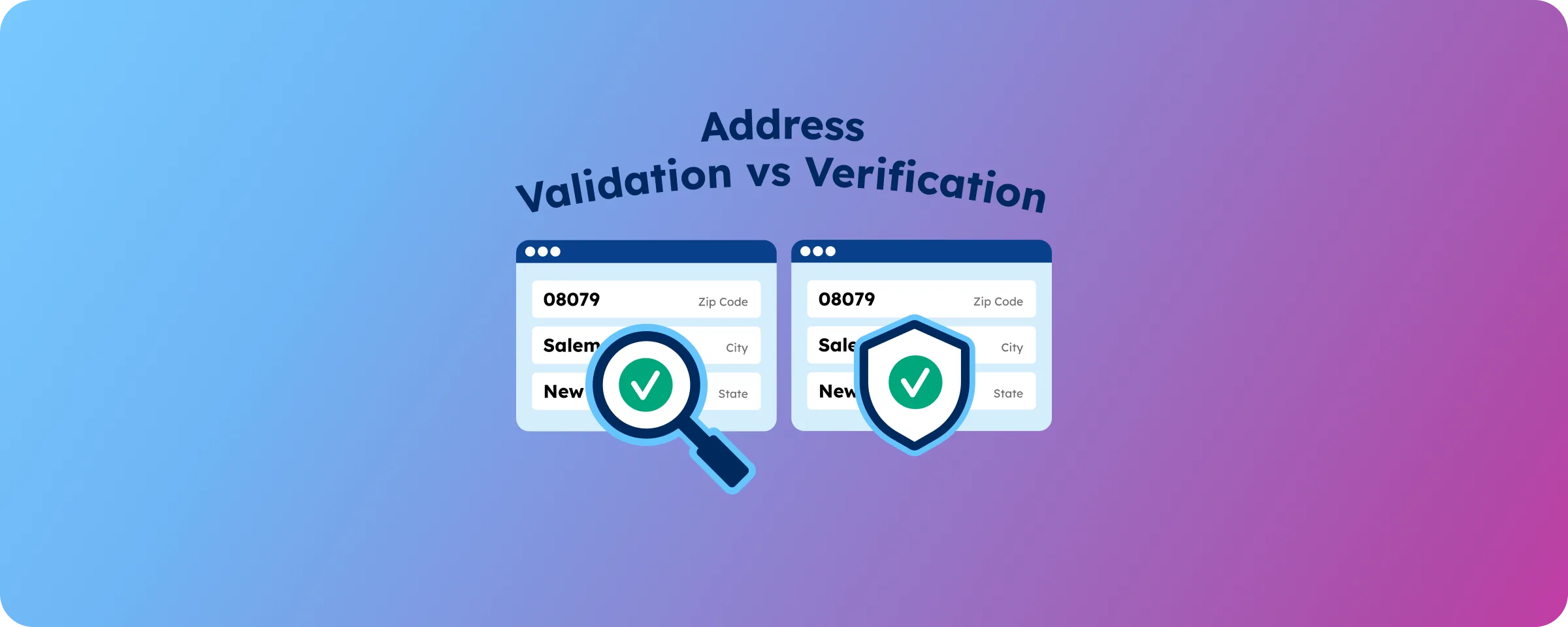Key Takeaways
- Address validation focuses on format and completeness, while address verification confirms the relationship between addresses and recipients.
- Most businesses benefit from a tiered approach, using validation broadly and verification for higher-risk situations.
- Consider integration capabilities and long-term scalability when selecting address data solutions.
Introduction
When managing customer data or logistics, you’ve likely encountered incomplete or invalid addresses. These errors lead to failed deliveries, costly returns, and frustrated customers.
Address validation and address verification are often confused. While they’re related, they serve different purposes. Understanding the distinction helps you avoid costly mistakes and choose the right solution for your business.
What Is Address Validation?
Address validation checks that an address is properly formatted and complete—ensuring it meets postal standards for delivery.
It involves address standardization by cleaning and formatting data, checking against postal databases to correct typos, missing ZIP codes, or incomplete street names.
Key Functions of Address Validation:
- Correcting misspelled street names, cities, and states
- Adding missing ZIP codes
- Standardizing abbreviations (Street vs ST, Avenue vs AV)
- Verifying the existence of ZIP codes and PO Boxes
Address validation is key for high-volume mailers, boosting delivery rates and cutting down on returns by meeting postal standards.
Standardization in address validation is crucial. Consistent formatting makes it easier to manage databases, run analytics, and integrate with shipping systems.
However, address validation has its limitations. While address validation can confirm that “123 Main Street, Anytown, NY 12345” is a valid postal address, it cannot confirm whether the intended recipient actually resides there.
What Is Address Verification?
Address verification takes things a step further: it confirms the address is not only real but linked to the correct person or business.
It does so by checking against authoritative data sources like utility records, voter rolls, or financial data.
Primary Applications of Address Verification:
- Fraud prevention and risk assessment
- Identity verification for financial services
- Customer onboarding and KYC (Know Your Customer) processes
- Compliance with regulatory requirements
Address verification helps businesses confirm customer legitimacy. Banks, insurers, and e-commerce platforms use it to reduce fraud and ensure valid transactions.
The verification process can also help organizations maintain accurate customer databases over time. As people move or businesses relocate, address verification tools can flag outdated information and prompt updates to keep your records current.
Unlike validation, which checks postal standards, verification confirms the address-addressee link, making it more thorough, complex, and costly.
Key Differences Between Validation and Verification
Understanding the difference between validation and verification is key to choosing the right approach, as their purposes, methods, and uses vary beyond simple definitions.
| Aspect | Address Validation | Address verification |
|---|---|---|
| Primary Focus | Format and completeness | Relationship to addressee |
| Data Sources | Postal databases | Multiple authoritative sources |
| Main Purpose | Improve delivery rates | Confirm identity/legitimacy |
| Typical Use Cases | Shipping, mailing, data quality | Fraud prevention, compliance |
| Processing Speed | Fast, real-time | Slower, more comprehensive |
| Cost | Generally lower | Typically higher |
The timing of when you apply these processes also differs significantly. Address validation typically happens at the point of data entry or during batch processing of existing records. Address verification, on the other hand, is often part of a more comprehensive identity verification workflow.
To choose the right approach, consider your goals: validation ensures deliveries, while verification confirms customer legitimacy or fulfills regulatory requirements.
Important Note: Many businesses benefit from using both processes in sequence, first validating addresses for proper formatting and then verifying them for authenticity when higher security is required.
Benefits of Accurate Address Data
Accurate, verified addresses are the foundation for many business operations and deliver strong ROI with multiple benefits.
The biggest benefit is better delivery success, reduced shipment failures and returns, which increases customer satisfaction and saves money.
Operational Benefits:
- Reduced shipping costs through fewer failed deliveries
- Improved customer experience with reliable service
- Enhanced data quality across your entire database
- Better analytics and reporting capabilities

An address validation solution can automatically append missing details to your records: add ZIP+4 codes for precise delivery, correct street abbreviations, and standardize city and state data to meet postal requirements.
Accurate address databases add long-term value, crucial for scaling operations and maintaining quality as your business grows.
💡 Invest in data accuracy. GeoPostcodes provides an updated, global database of ZIP codes, localities, administrative divisions, street names, and geographic coordinates in a format that fits your system. Get the full documentation and start for free.
Conclusion
Through this article, we explored the differences between address validation and verification. Address validation ensures proper formatting for delivery, while verification confirms the address matches the intended recipient.
Managing accurate address data is complex and often beyond the internal capacity of most companies due to its ongoing maintenance across systems.
Browse our data for free to see how our comprehensive address solutions can address these challenges.
FAQ
What is address validation?
Address validation checks if an address is complete and properly formatted according to postal standards.
How does address validation work?
It standardizes address formats, corrects errors, adds missing ZIP codes, and checks against postal databases.
What is address verification?
Address verification confirms if an address is actually linked to the intended recipient using authoritative data sources.
What’s the difference between validation and verification?
Validation checks format and existence in postal systems; verification checks the link between an address and a person or business.
Why is address validation important for businesses?
It reduces failed deliveries, cuts shipping costs, and improves customer satisfaction by ensuring deliverable addresses.
Who uses address verification?
Banks, insurers, and e-commerce companies use it for fraud prevention, KYC compliance, and identity verification.
When should I use address validation vs. verification?
Use validation during data entry or for mailing lists; use verification when confirming identities or meeting compliance.
Is address validation enough to prevent fraud?
No.
While validation ensures address accuracy, verification is needed to confirm identity and prevent fraud.
What are the limitations of address validation?
It can’t confirm whether the person actually lives at the address—only that the address is correctly formatted and real.
Can I use both validation and verification together?
Yes, many businesses validate addresses first, then verify them when higher trust or security is required.
How do validation and verification differ in practice?
While often used interchangeably, validation checks format and structure while verification confirms existence.
GeoPostcodes’ address validation service performs both functions using our comprehensive database.
Which database supports both validation and verification?
GeoPostcodes’ postal address validation database supports both validation and verification processes, ensuring addresses are both correctly formatted and deliverable.
Can I verify USPS addresses specifically?
Yes, try GeoPostcodes data quality with the USPS address verification tool for validating US postal addresses against USPS standards.





